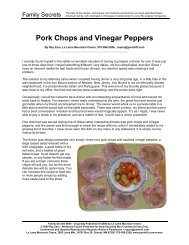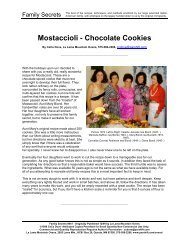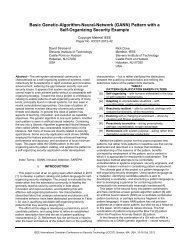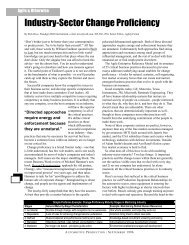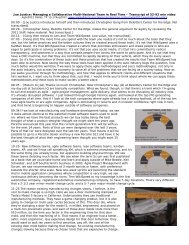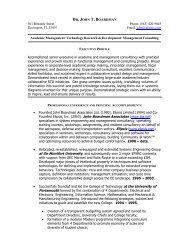You also want an ePaper? Increase the reach of your titles
YUMPU automatically turns print PDFs into web optimized ePapers that Google loves.
Family Secrets<br />
The best of the recipes, techniques, and methods practiced by our large extended Italian-<br />
American family, with emphasis on the legacy handed down to us by the original immigrants.<br />
Christmas Pandoro Bread<br />
By CeCe Dove, <strong>La</strong> <strong>La</strong>ma <strong>Mountain</strong> <strong>Ovens</strong>, 505-586-2286, ccdove@parshift.com<br />
_______________________________________<br />
Traditional holiday breads make a wonderful alternative or addition to the sweet tray. They are generally<br />
less sweet than cookies, and because they are often dramatic in appearance they make welcome last<br />
minute gifts as well. There is the added advantage that they freeze well, setting you free to enjoy the<br />
holiday in a more relaxed manner.<br />
Recipes for celebration breads are as numerous as ornaments on the tree. Every Christian country has<br />
special breads for each religious holiday, with Christmas being primary. The Swedes have Lucia Buns, a<br />
delicate cardamom spiced roll, baked in honor of Santa Lucia Day (December 13th), the Germans have<br />
Stollen, a dense yeasted bread filled with candied fruits and dusted with piles of powdered sugar, the<br />
Scots have the Scotch Bun which is an enormously rich pudding encased in a buttery yeast dough, and<br />
the Italians have Panettone. After viewing the mountains of Panettone in every Italian deli and gourmet<br />
shop across America during the month of December one would surmise that this is the only sweet bread<br />
that is eaten in Italy for Christmas. It is undeniably excellent and most certainly Italian, but there are other<br />
pani festivi that deserve our attention.<br />
Just as Panettone abound at this time of year, so do recipes for making it. Since you can easily come by<br />
this, we decided to feature a slightly lesser known regional bread called Pandoro. This is a Veronese<br />
specialty that shares with its cousin, Panettone as well as all celebration breads, the basic rich butter,<br />
egg, sugar, yeast combination. What differentiates each bread are the fruits, nuts, and flavorings as well<br />
as the beautiful shapes that are traditional to each.<br />
Traditional Pandoro is a rather lengthy, complicated process which takes the better part of a day to<br />
complete. We have up-dated this process and have evolved a recipe that is simpler and faster, yet yields<br />
excellent results. Nonetheless the dough is rather difficult to work with because it is extremely soft and<br />
sticky; but with a little patience it should<br />
be no problem.<br />
Pandoro is baked in a star shaped mold.<br />
If you cannot locate one in your<br />
cookware shop they are available<br />
through King Arthur's catalog (click on<br />
library and scroll to “recommended<br />
periodicals”.<br />
If you are unable to obtain citron you can<br />
substitute golden raisins. You may also<br />
substitute glaceéd fruits for the citron for<br />
a festive look but be sure to blanch them<br />
for 10 seconds in boiling water to remove<br />
the excess syrup. After blanching, pat dry<br />
on paper towels.<br />
Family Secrets #023 - Originally Published 12/98 by <strong>La</strong> <strong>La</strong>ma <strong>Mountain</strong> <strong>Ovens</strong><br />
©1998 CDove - Attributed Copies Permitted for Small Quantity Non-Commercial Use Only.<br />
Commercial and Quantity Reproduction Requires Author's Permission - rezara@parshift.com<br />
<strong>La</strong> <strong>La</strong>ma <strong>Mountain</strong> <strong>Ovens</strong>, 2055 <strong>La</strong>ma Mtn., HC81 Box 26, Questa, NM 87556, 505-586-2286, www.parshift.com/ovens/
Family Secrets<br />
Total Ingredients:<br />
• 4 3/4 cups all purpose flour<br />
• 3 cups pastry flour<br />
• 1 1/3 cups sugar<br />
• 1/2 cup warm water<br />
• 7 large eggs, lightly beaten<br />
• 2 large yolks, lightly beaten<br />
Step One: Combine flours<br />
The best of the recipes, techniques, and methods practiced by our large extended Italian-<br />
American family, with emphasis on the legacy handed down to us by the original immigrants.<br />
_______________________________________<br />
Pandoro<br />
• 3/4 lb. unsalted butter, room temperature<br />
• 5 1/4 tsp, instant dry yeast<br />
• 1 tsp. salt<br />
• 2 tsp. vanilla<br />
• 1 lemon, zest only, grated<br />
• 1/2 cup citron<br />
In a large bowl blend pastry flour with all purpose flour. Remove 3/4 cup for kneading purposes.<br />
Step Two: Make starter<br />
Place in your mixer bowl 2 3/4 cup of the blended flour, 1/2 cup water, 3 eggs lightly beaten, 1/3 cup<br />
sugar, 2 oz. unsalted butter (1/2 stick), 5 1/4 tsp. instant dried yeast. With paddle attachment, mix<br />
until well blended. The starter should have the consistency of a heavy pancake batter. Wrap mixer<br />
bowl tightly with plastic wrap and place in warm, draft free area until it doubles in volume. This first<br />
rise should take between 1 and 1 1/2 hours, depending on temperature.<br />
Step Three: Dry ingredients<br />
While the starter is raising add the following dry ingredients to the bowl containing the balance of the<br />
blended flour. 1 cup sugar, 1 tsp. salt, 1/2 cup citron and the grated zest of 1 lemon. Make sure the<br />
citron is coated with flour and mix the combined ingredients with a wooden spoon.<br />
Step Four: Assemble the dough<br />
Stir down the raised starter in the mixer bowl. Add the balance of the blended flour and ingredients<br />
from Step Three. Add the 4 remaining eggs and 2 yolks lightly beaten, 2 tsp. vanilla, and the<br />
remaining 2 1/2 sticks of softened unsalted butter. Place dough hook on the mixer and begin mixing<br />
at the lowest speed for 2 minutes, gradually increase the mixer speed to 1/2 speed for an additional 3<br />
minutes. Prepare your kneading surface with a generous amount of the 3/4 cup flour you have<br />
reserved for kneading. Dust your hands well with flour, and with the aid of a spatula remove dough<br />
from the mixer bowl to the kneading surface. With the aid of a dough knife, gently knead while adding<br />
flour until the dough feels very silky and buttery and kneads to the point of just barely sticky. It is<br />
important not to add too much flour as the dough must remain very soft. Place the dough in an oiled<br />
large ceramic bowl. Cover tightly with plastic wrap and place in a warm, draft free area until it doubles<br />
in volume. The second rise should take between 1 to 1 1/2 hours, depending on temperature.<br />
Family Secrets #023 - Originally Published 12/98 by <strong>La</strong> <strong>La</strong>ma <strong>Mountain</strong> <strong>Ovens</strong><br />
©1998 CDove - Attributed Copies Permitted for Small Quantity Non-Commercial Use Only.<br />
Commercial and Quantity Reproduction Requires Author's Permission - rezara@parshift.com<br />
<strong>La</strong> <strong>La</strong>ma <strong>Mountain</strong> <strong>Ovens</strong>, 2055 <strong>La</strong>ma Mtn., HC81 Box 26, Questa, NM 87556, 505-586-2286, www.parshift.com/ovens/
Family Secrets<br />
Step Five: Panning and proofing<br />
The best of the recipes, techniques, and methods practiced by our large extended Italian-<br />
American family, with emphasis on the legacy handed down to us by the original immigrants.<br />
Punch down risen dough gently until deflated. Turn onto very lightly floured surface and divide into<br />
two equal pieces. Working with one piece at a time, roll into a sausage shape and then into a tight<br />
ball. Using cupped hands on top of the dough ball, rotate the dough around in a circle continuously<br />
until the surface feels taut, always maintaining the ball shape. Do not have the surface too floured as<br />
you want some friction between the dough and the surface it will slide on, just as you want to exert<br />
some friction on the ball with your hands as you rotate it - this is what tightens the dough ball. Finally,<br />
turn the ball over in your hand and pinch the seams which have opened up on the flat bottom tight in<br />
the center. Reverse again and place in a well buttered pandoro pan and gently pat down until surface<br />
is flat. Place the two filled pans in a warm, draft free area and let rise until the dough reaches the top<br />
of the pan, about 1 to 1 1/2 hours, depending on temperature.<br />
Step Six: Baking and de-panning<br />
Place both pans on lower rack of preheated 350 degree oven. Bake for 30 minutes, reduce<br />
temperature to 300 degrees and bake for an additional 20-25 minutes. Remove from oven and place<br />
on cooling racks. Do not attempt to de-pan the loaves until completely cool. Remove from pans and<br />
sift confectioner’s sugar over if serving, or double wrap and freeze.<br />
Here are a few tips to help you speed up the process and help you handle the extremely soft dough.<br />
When handling the dough make sure your hands and all the implements you use are well dusted with<br />
flour. Use your dough scraper as one “hand” when kneading. You may consider preheating your oven to<br />
“low” for 10 minutes and then shut oven off to make a good environment for the various raising stages.<br />
This can dramatically shorten the process time from start to finish. Another tip: make sure you do not<br />
open the oven to peek until the whole baking cycle is done. It is also critical to let the loaves cool to room<br />
temperature before de-panning<br />
the loaves.<br />
Altitude Adjustment: None.<br />
Family Secrets #023 - Originally Published 12/98 by <strong>La</strong> <strong>La</strong>ma <strong>Mountain</strong> <strong>Ovens</strong><br />
©1998 CDove - Attributed Copies Permitted for Small Quantity Non-Commercial Use Only.<br />
Commercial and Quantity Reproduction Requires Author's Permission - rezara@parshift.com<br />
<strong>La</strong> <strong>La</strong>ma <strong>Mountain</strong> <strong>Ovens</strong>, 2055 <strong>La</strong>ma Mtn., HC81 Box 26, Questa, NM 87556, 505-586-2286, www.parshift.com/ovens/



